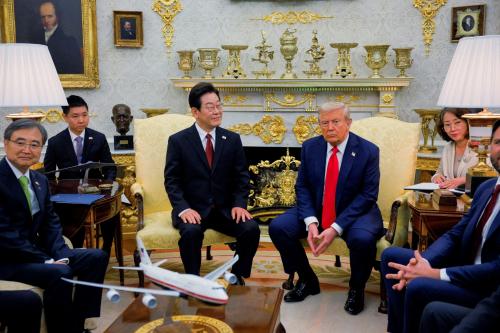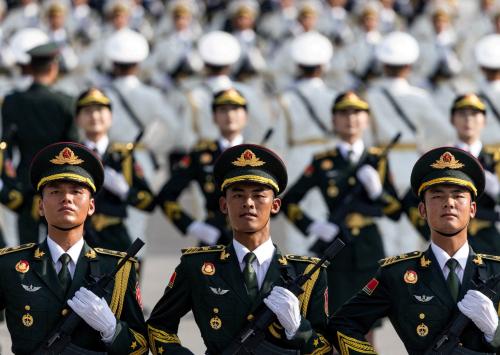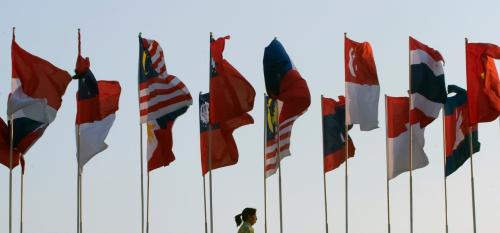President Obama begins a four-nation trip to Asia this Tuesday, with stops in Malaysia, South Korea, Japan and the Philippines. Many observers are looking at his trip through the lens of the policy announced in Obama’s first term, the “pivot,” or “rebalance,” to Asia. Others are wondering how the recent crisis in Ukraine might affect U.S. attention in the Asia-Pacific region. Here is some of what Brookings experts have been saying about the trip.
Getting out of Afghanistan, staying out of Libya, Syria and Ukraine, and working hard to get a nuclear deal with Iran, all strengthen the United States to play well in the main area of geopolitics: East Asia. — Richard Bush to the Straits Times
Bruce Jones answered a series of questions about the president’s agenda, including what effect the Ukraine crisis may have, whether the U.S. can truly “pivot” to Asia, and whether the trip is about trying to contain China.
Mireya Solís wrote that “reassurance” is the keyword in President Obama’s summit meeting with Japan’s Prime Minister Shinzo Abe. “Trade,” she said,
looms large in the success of the Obama-Abe summit. The key here is that the TPP agenda opens a new chapter in U.S.-Japan relations—not only because of the unprecedented ambition in the economic sphere (across the board tariff reductions, tackling of non-tariff barriers, and drafting new rules of trade and investment for the Asia-Pacific), but also because the outcome of the TPP talks has emerged as a focal point in solving the foreign policy credibility problems that both countries face.
Michael O’Hanlon and James Steinberg write on the U.S.-China relationship, and argue that “a more comprehensive approach to the changing tectonics of East Asia is needed: one that treats the territorial disputes not as isolated problems, but rather addresses the fundamental problem of dealing with a rising power.”
Joshua Meltzer calls the Trans-Pacific Partnership trade deal “the most significant trade agreement the US is negotiating, representing 40% of world trade and a destination for over 60% of US exports.”
In their “Big Bets & Black Swans” paper, published in January, Jonathan Pollack and Jeffrey Bader wrote of the rebalance policy that:
Our challenge remains threefold: to protect and enhance America’s long-term political, economic and security interests; to reaffirm and deepen U.S. relationships with long-standing allies and partners while reaching out to new ones; and to achieve the first two goals without alienating a rapidly emerging China or generating open-ended military rivalry across the region. These policy dilemmas will continue to require adroit management across a very broad spectrum of issues and interests, and they will at times continue to require your direct engagement.
At an event last Friday, panelists discussed the administration’s Asia strategy in the context of the Ukraine crisis. During the event, Michael O’Hanlon remarked that the rebalance “was never a dramatic shift in American resources in the first place.” Citing data on U.S. defense spending, O’Hanlon observed that “at most we planned to reallocate $10 billion” of $600 billion in total defense spending to the Asia-Pacific region, and that Navy ships stationed in the Pacific could still go to the Persian Gulf and other locations if they had to. However, O’Hanlon said, the U.S. lost whatever momentum it had at the end of the first Obama term, “largely because diplomatic attention has moved away from the Asia-Pacific with a change in personnel in the Obama cabinet and top leadership, and also because sequestration has put downward pressure on the defense budget.”
Kenneth Lieberthal opened his remarks by stating that “words and attention matter” when talking about how the rebalance is seen in Asia today. His opening set of remarks from the program are reprinted here.
Jonathan Pollack offered his own “to-do list” for the president’s trip. The “preeminent goal for President Obama” during his trip, said Pollack, is to show that the rebalance toward the Asia-Pacific region has “staying power and genuine strategic significance” and is “not a code word for counterbalancing of Chinese policy.” Other goals, according to Pollack, are:
[A] much fuller strategic conversation across the Asia-Pacific region, in this case country by country. … We still in my view seem stuck very, very much in bilateral relationships when our aspirations are to a larger, regional vision. Now I understand there is a lot of multilateral activity in Southeast Asia, much less of it in Northeast Asia, which is still without question the focal point of our power—military, economic and diplomatic—even compared to the growing importance that we attach elsewhere in the region. …
[A] parallel need to discuss burden- and responsibility-sharing when our own capacity to sustain a global strategy is increasingly in question. … If you are asking questions about what the United States can realistically expect to do, it is going to be a function of three alternatives: either, one, we will somehow convince Congress and others to commit more resources to what we do in the region; number two, we will have to make do with less; or number three, we make very, very clear to our allies and partners in the region that we expect commensurate contributions on their part if we are going to achieve a larger vision for the region in the long term. …
[V]ery candid, bilateral discussions on specific policies of some of our key partners on trade, on history, on other issues which are at variance with American interests and policy goals. We cannot be a disinterested third party. Even if we argue it will still up to the states in the region to find a way to reconcile these differences. I don’t see us being able to sit on the sidelines. The best case in point is the stunning anomaly of the incredible frigidity in the relationship between Korea and Japan. Korea and Japan after all are America’s two most important regional allies. They are both headed by right-of-center governments. They barely speak to one other. … But as we are all familiar there are deep grievances here as both of these countries try to define a role for themselves in the world that is to come and it’s finding their interests in very, very great conflict with one another. …
[C]an we actually see the kind of intelligent discussion that needs to be held almost country-by-country about longer-term relationships with China; longer-term questions about its international position and role? In this respect it’s often asserted that no one in Asia wants to force a choice between the United States and China.
At the same time I think it would be imprudent for the United States to, in effect, force a choice between China and Japan. For different reasons but for very much related reasons, both are hugely important to American interests. Japan is long term ally, and China of course is very much the rising power.
A successful strategy has to find some kind of an inclusive concept lest the future of this region go in directions that we don’t want to see.
Get archived research and commentary from Brookings experts on Asia and the Pacific here. Of particular interest is a speech delivered by Richard Bush in January 2012, two months after the official roll out of the administration’s rebalance strategy, titled “The Response of China’s Neighbors to the U.S. ‘Pivot’ to Asia.”
The Brookings Institution is committed to quality, independence, and impact.
We are supported by a diverse array of funders. In line with our values and policies, each Brookings publication represents the sole views of its author(s).




Commentary
What Brookings Experts Are Saying about President Obama’s Asia Trip
April 23, 2014